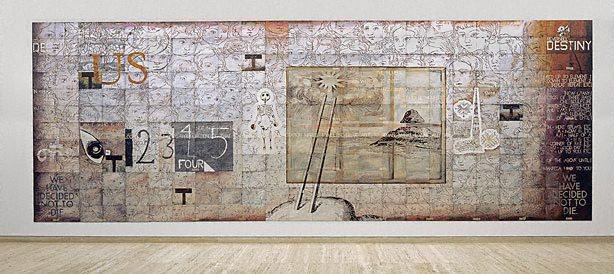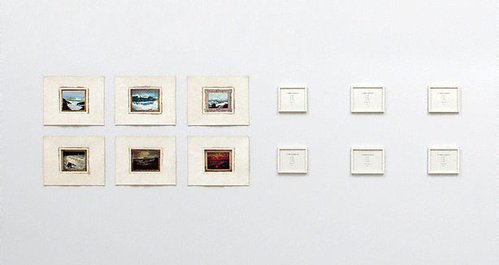-
Details
- Date
- 1998
- Media category
- Painting
- Materials used
- gouache, synthetic polymer paint on 288 canvas boards, nos. 52594-52881
- Dimensions
- 305.0 x 853.0 cm overall installed
- Credit
- Patricia Lucille Bernard Bequest Fund and the Don Mitchell Bequest Fund 2005
- Location
- Not on display
- Accession number
- 340.2005.a-bbbbbbbbbbbb
- Copyright
- © Imants Tillers
- Artist information
-
Imants Tillers
Works in the collection
- Share
-
-
About
'Monaro' is the first major painting that Tillers completed after moving from Sydney to Cooma in the Monaro district in 1997. It follows the 'Diaspora' series begun in 1992 which considered the themes of "identity, displacement, loss and redemption" [notes from the artist]. As the child of Latvian immigrants who moved to Australia at the end of World War 2 these themes have a personal resonance, while they also address the great population shifts that have occurred in the 20th century, whether voluntary or forced, driven by war, economic necessity or the desire for new horizons. 'Monaro' is a consideration of place in the light of the exploration of themes of identity central to Tillers' recent practice.
While 'Monaro' contains the range of appropriated imagery that characterises Tillers practice, it is also a response to the landscape of the Monaro region. The all over field of soft gray tonalities, with subtle brown and pink tones, embodies a sense of the treeless eroded hills of this region. Over this field are painted the heads of cherubim, derived from a drawing by the German proto-Romanticist Philipp Otto Runge (1777-1820), which was realised in a frieze in the large version of Runge's painting 'Morning' c.1808-09. Tillers has an interest in the legacy of romanticism in German art in the later part of the 20th century, something these cherubim may also embody. In 'Monaro', the cherubim surround an image of a mountain with its peak cut across by a painting stretcher, derived from the artist Sigmar Polke.
Other key references in 'Monaro' include the 'T' panels and the numbers which are cited from New Zealand artist Colin McCahon, whose bare landscapes are a metaphysics of place. The skeleton is perhaps unexpectedly from contemporary British artist Chris Offili. To the right of the transparent canvas with the mountain is an image of St Peters, a church in Riga, capital of Latvia, which was rebuilt after being destroyed in WW2. The original image this is from was found by Tillers in Cooma, a coincidental connection between his new home and his parent's origins. The text within 'Monaro' has a number of sources, but includes German artist Joseph Beuys for the words on the right edge. The quotes over the Polke image are from a poem by French symbolist poet Stéphane Mallarmé. On the left edge of 'Monaro', the text lists twenty ways in which the name of the town Nimmitabel, which is near Cooma, has been spelt over the last century.
While deciphering the references is always rewarding in Tiller's work, they are not a series of clues which reveal an encoded meaning. The citations are part of the experiential whole, mapping fields of allusion rather than defining cause and effect. The themes of identity that occurred in the 'Diaspora' series are intertwined here with reference to a specific place. As Tillers has written, "…issues of locality and identity have become uppermost in my mind and have made their presence felt in my recent work, not as literal representations of landscape, of the grass, hills, sky, clouds or rocks around me, but as 'evocations', through text and other layered visual elements." [Imants Tillers, 'When Locality Prevails', 'Heat¸no.8', Giramondo, Sydney, 2004, pp. 114.]
-
Exhibition history
Shown in 7 exhibitions
Prayer for rain, Raglan Gallery and Cultural Centre, Cooma, , 1998–1998
Expanse: Aboriginalities, spatialities and the politics of ecstasy, Anne & Gordon Samstag Museum of Art, Adelaide, 04 Sep 1998–03 Oct 1998
Imants Tillers, Monaro 1998, Museum of Modern Art at Heide, Melbourne, Nov 1998–Nov 1998
Imants Tillers: nature speaks, Sherman Galleries, Paddington, 26 May 1999–12 Jun 1999
Towards Infinity: works by Imants Tillers, Museo de arte Contemporáneo de Monterrey (MARCO), Mexico, 24 Sep 1999–01 Jan 2000
Imants Tillers: one world/many visions, National Gallery of Australia, Canberra, 14 Jul 2006–16 Oct 2006
Imants Tillers 'Journey to Nowhere', Latvian National Museum of Art, Riga, 06 Jul 2018–30 Sep 2018
-
Bibliography
Referenced in 8 publications
-
Graham Coulter-Smith, The Postmodern Art of Imants Tillers: Appropriation 'en abyme', 1971-2002, London, 2002.
-
Laura Murray Cree and Nevill Drury (Editors), Australian painting now, Sydney, 2000, 284, 286-287 (illus.).
-
Deborah Hart (Curator) and Imants Tillers (Artist), Imant Tillers: one world many visions, 'Monaro 1998', pg. 62-65, Canberra, 2006, 62 (colour illus.), 63-65.
-
Charles Merewether, Towards Infinity: works by Imants Tillers, Mexico, 1999, 33 (colour illus.).
-
Ian North, Expanse: Aboriginalities, spatialities and the politics of ecstasy, Adelaide, 1998, 25 (colour illus.).
-
Sherman Galleries, Imants Tillers: nature speaks, 1999, (colour illus.).
-
Imants Tillers, Monaro 1998, Victoria, 1998, 6-9, (colour illus.).
-
Wayne Tunnicliffe, Contemporary: Art Gallery of New South Wales Contemporary Collection, 'Cultural memory, critical distance', pg.154-203, Sydney, 2006, 196-197 (colour illus.). illustration on pg.197 is a detail
-




